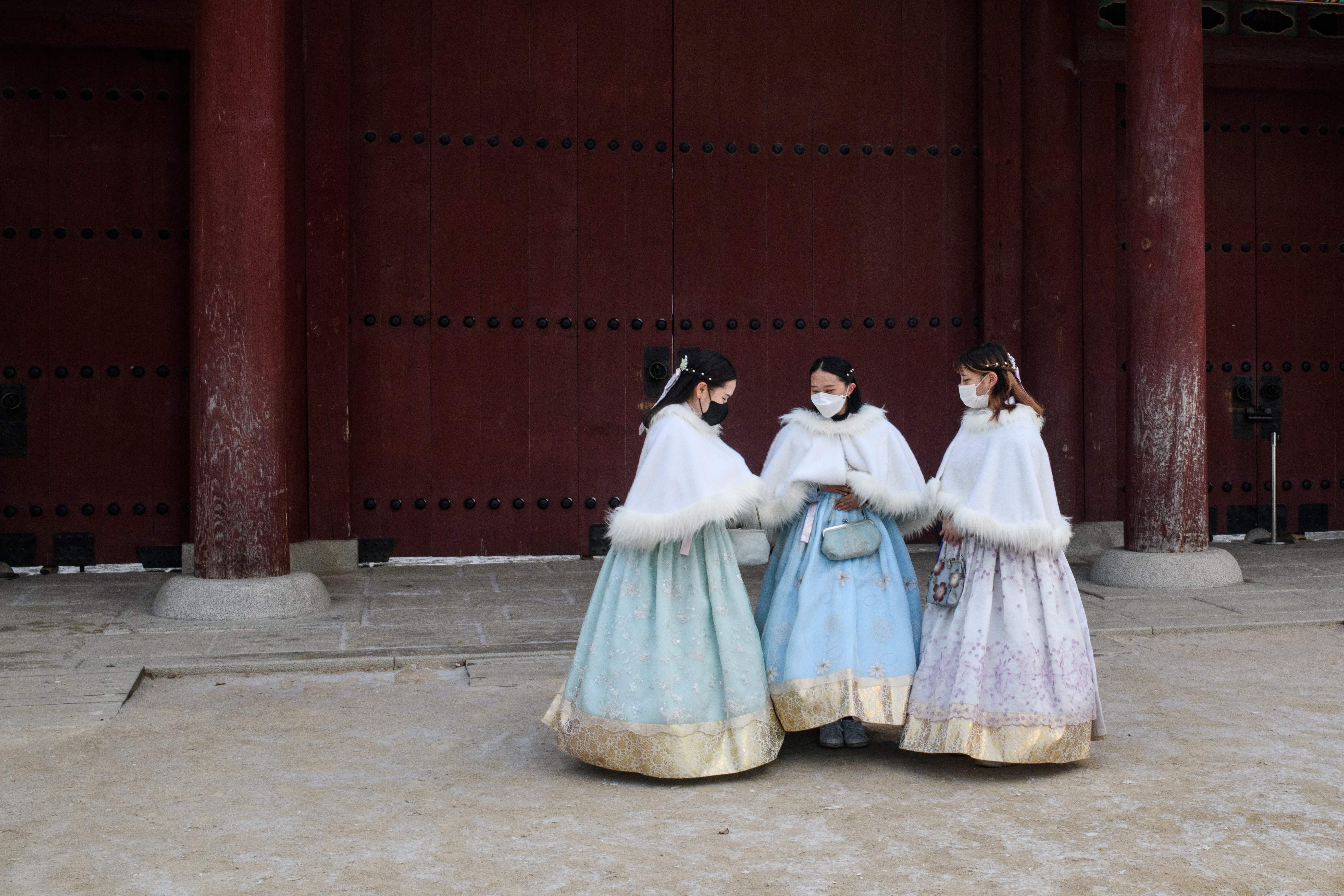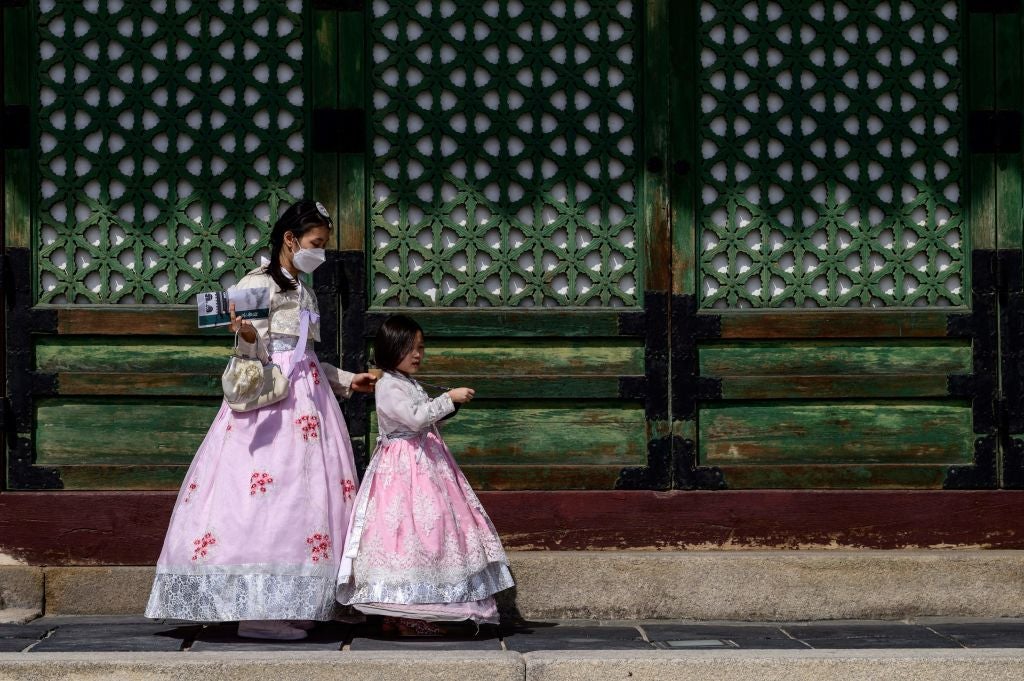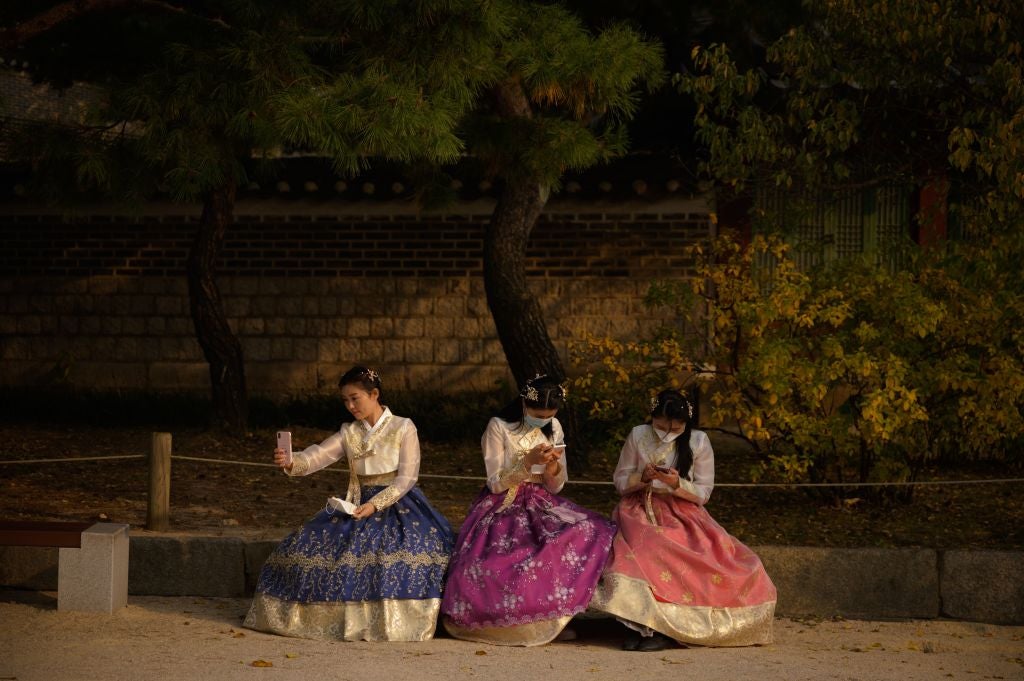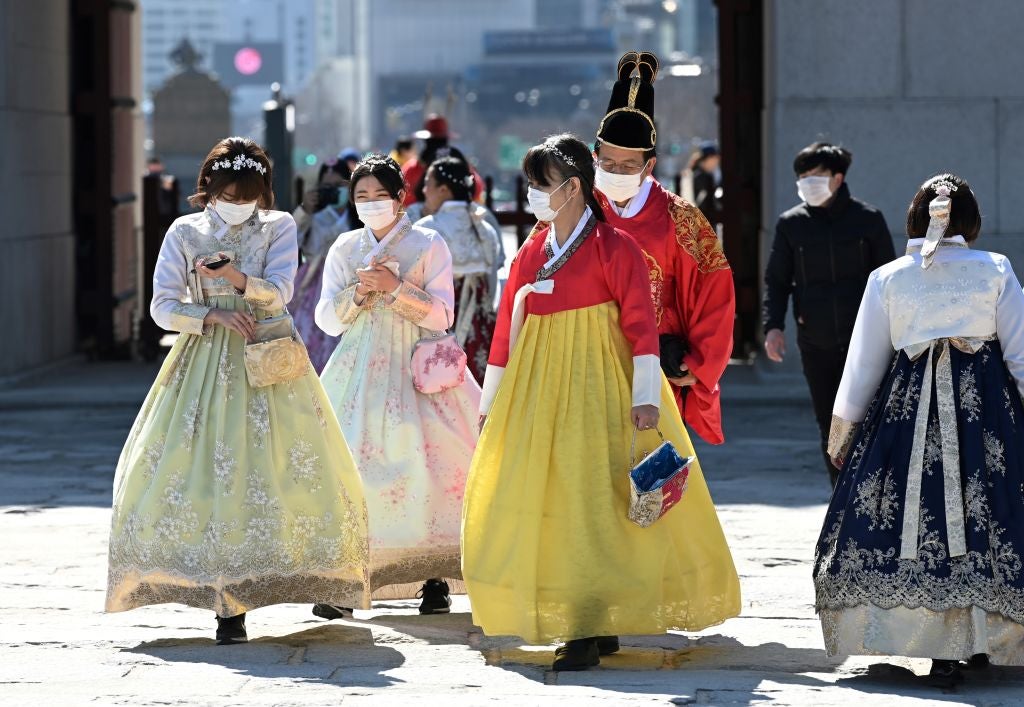The Independent's journalism is supported by our readers. When you purchase through links on our site, we may earn commission.
‘It’s a really important question of identity’: The history of a culturally significant Korean garment
The word ‘hanbok’ translates to ‘Korean clothes’ and it used to imply everyday wear; though less prevalent these days, the costume remains just as important, explains Aileen Kwun

Your support helps us to tell the story
From reproductive rights to climate change to Big Tech, The Independent is on the ground when the story is developing. Whether it's investigating the financials of Elon Musk's pro-Trump PAC or producing our latest documentary, 'The A Word', which shines a light on the American women fighting for reproductive rights, we know how important it is to parse out the facts from the messaging.
At such a critical moment in US history, we need reporters on the ground. Your donation allows us to keep sending journalists to speak to both sides of the story.
The Independent is trusted by Americans across the entire political spectrum. And unlike many other quality news outlets, we choose not to lock Americans out of our reporting and analysis with paywalls. We believe quality journalism should be available to everyone, paid for by those who can afford it.
Your support makes all the difference.With spare, elongated lines and broad shapes that bloom into a voluminous silhouette, the traditional Korean hanbok, made to accommodate movement, is as beautiful as it is functional.
The long-sleeved jacket invites a sense of ritual, with a stately V-shaped neckline and ribboned coat strings that are meant to be tied into a single-looped bow from the wearer’s left to right. A wrapped skirt, floor-length, worn high and cinched tightly upon the chest, or trousers, loosefitting with ankle ties that puff each leg up like parachutes, complete the outfit.
The word “hanbok” translates to “Korean clothes”, and before the introduction of western styles to Korea, it was simply everyday wear. While period shows depicting this earlier era are common fare on Korean television, the new Apple TV+ series Pachinko is a watershed moment in American television entertainment. The trilingual series, told in Korean, Japanese and English, takes care to portray, in intimate, humanising detail, such elements of everyday Korean life from the early 20th century.
Hanbok has reflected variations and styles over its more than 2,000-year history: jacket and skirt hemlines have shortened and lengthened; sleeves have widened, rounded or narrowed over cycles of subtle change. Today, contemporary designers still take great inspiration from the garment, yet the most traditional form continues to take cues from the Joseon era, a dynastic period that lasted from the late 14th century to the early 20th century.
“‘Hanbok’ is a collective term,” as Kyunghee Pyun, 49, a dress historian and professor at the Fashion Institute of Technology, says, “just as ‘kimono’ and ‘kaftan’ each represent a set of clothes, not individual garments.” Throughout history, she notes, hanboks have been made predominantly by women, and much of the thriving hanbok industry today can be credited to their resilience. “It was these women as entrepreneurs who created a market for wedding and special-occasion hanbok.”
They have also kept its tradition alive. As western attire is now everyday wear for Koreans, hanbok-wearing will soon become part of a formal set of customs designated as “intangible cultural heritage,” the South Korean Cultural Heritage Administration recently announced.
In Korean culture and among diasporic communities, the garment has become ubiquitous in family photos and gatherings, worn for traditional holiday celebrations such as Seollal (lunar new year) and Chuseok (autumn harvest); celebratory life events such as weddings, 60th and first birthdays; and funerals.
“Growing up, hanbok was very much this ritualistic costume,” says Jillian Choi, 37, an art and design consultant whose family immigrated from South Korea to New Jersey in the 1970s. “My mother had a ritual of unwrapping the hanbok on New Year’s Day, laying them out, and teaching us how to put it on and tie the ribbons in that special way. Hanbok was my tangible connection to this special place, this idea of Korea.”
I’ve always felt proud of our business for being woman-owned, minority-owned and how we came up in our community through word-of-mouth
While Choi, like many Korean American children, grew up wearing hanboks sent from relatives overseas, hanbok boutiques are enduring fixtures in major cities such as Los Angeles, Atlanta and New York, home to some of the largest diasporic Korean communities in the country.
On Western Avenue, in the heart of Los Angeles’ Koreatown, Laura Park, 58, has been operating her business, House of LeeHwa, for more than 30 years.
Park’s family history in the artisanal hanbok textile trade traces back to her great-grandparents in North Korea. Her grandmother, a refugee of the Korean war, brought their business to South Korea and passed it down to Park’s mother, who then established a wholesale and retail trade at Gwangjang Market, one of Seoul’s oldest shopping arcades filled with shops and stalls selling street food, homewares, handicrafts, textiles and “market hanbok,” as off-the-rack ensembles are called.
“When I was young, I grew up playing on the factory floors, playing beneath the machines,” says Park, who creates all of her designs with textiles imported from Korea. From its beginnings as a one-woman home operation in 1990, LeeHwa has survived through challenging moments: the Los Angeles riots, the Northridge earthquake and, most recently, closures because of the pandemic.
“I’ve always felt proud of our business for being woman-owned, minority-owned and how we came up in our community through word-of-mouth,” says Park’s daughter, Estella Park Riahi, 31, who helped expand LeeHwa to online retail and ushered it into the social media age.

The store has thrived in recent years, Park Riahi said, drawing a more diverse clientele who are not of Korean descent but are curious to learn more about the culture. That interest has been bolstered by the popularity of K-pop bands who have worn modernised hanbok ensembles onstage, as well as more traditional, historical styles in photo shoots and press appearances.
The classic semiformal hanbok worn today, made from fine silk and ramie in an array of colors, is largely derived from styles worn by royalty and upper classes in the late Joseon era. During that period, a rich symbolism of ornate patterns, materials, colours and accessories was historically coded to signify gender, marital status, class and rank.
“Nowadays, silk hanbok is very common, but in the late Joseon era, only the royal family and very high-class gentry could wear silk garments,” said Minjee Kim, 52, a hanbok scholar and dress historian.
Koreans who were not in the upper ranks of society, by contrast, produced their own clothing at home in preindustrial times, using natural dyes and readily available materials such as hemp, linen and cotton. The white hanbok, in particular, has been symbolic for Korean people throughout history, conveying purity as well as solidarity and resistance in times of political strife.
“Up until the Joseon dynasty, there was a state dress code that enforced people to wear a certain style of clothing,” Kim says. “That sort of thing became abolished through Korea’s modernisation.”

As Korea opened its doors to international trade in the late 19th century, an influx of western styles arrived. After Japan annexed the country in 1910, Koreans experienced a campaign of cultural erasure and material extraction that sought to oppress their heritage in all aspects of daily life, extending to land ownership, language, food and clothing.
“Once you get past statistics and numbers of how many who moved, how people died, how many people were displaced, you drill down to the stories of the people who actually lived,” says Soo Hugh, the creator and showrunner of Pachinko. Adapted from Min Jin Lee’s novel, the story follows four generations of a resilient immigrant family across Korea, Japan and New York, shining a light on a painful chapter of modern Korean history marked by years of occupation, war and separation.
“Growing up, there are so many blank spaces, wondering how something happened, or not understanding. Sometimes it takes a work of fiction to be able to open up that conversation,” Hugh, 44, says. “Obviously, I am the generation that carries the burden of that sacrifice, and yet so much amnesia as well.”
For much of the first half of the season, the protagonist Sunja, a Korean girl born during the Japanese occupation to humble, working-class parents in Busan, wears hanboks made from crushed cotton and muslin as she cooks, runs errands and tends her mother’s boardinghouse. Rumpled and gently soiled, it’s not an outfit for a special occasion. In addition to ensuring historical accuracy, Hugh noted, “hanbok made from hemp and cotton moves differently. We wanted to capture that detail as a storytelling tool for our characters, and their economic conditions as well.”
With the continuing increase of anti-Asian violence and scapegoating during the pandemic, some Korean Americans have also embraced hanbok as a symbol of cultural pride
For the show, costume designer Kyunghwa Chae, 46, who has worked on dozens of South Korean film productions, looked at historical materials – books and scholarly articles, old Korean films, magazines and archival photos – and consulted with academics to inform her designs.
In the novel, Lee writes of how western-style clothing played a part in the intricate code-switching of this era and how “the chill against identifiable Koreans was obvious” for Zainichi – ethnic Koreans who emigrated to Japan during occupation – a detail that also unfolds on screen. As Sunja arrives at her new home in Osaka, Japan, where watchful eyes discern her as the other, she sheds her hanbok jacket and skirt in favour of sweaters and wool coats to blend in. Weeks later, she bowls over in agony when she realises her sister-in-law has washed her hanbok, erasing the last lingering scents of salty air and seawater of her hometown.
“I wanted to capture that contrast of Sunja’s hanbok changing into a completely different style, bit by bit,” Chae says. “You notice her hanbok gradually changing, piece by piece, until she has adopted Japanese or western-type clothing,” she added, as an attempt to assimilate into a country where she is unwanted but nonetheless determined to survive.
In a story such as this, where the viewer travels time and place, many small details had to be addressed.
“Clothing is an indulgent conversation in some ways,” Hugh says, because the working-class Koreans were not discussing whether putting on a suit defines them as a westerner. “At the same time, it’s a really important question of identity, especially in Korea,” she said.

Hugh, who was one of only a few Korean American children growing up in Towson, Maryland, in the 1980s, recalled how wearing hanbok to school for multicultural days could garner unwanted attention – a feeling of otherness. “Now, when you read and learn about the history of our clothes, putting on a hanbok feels empowering, and also something that needs to be protected a little bit,” she said. “Working on Pachinko has put so much of my past in context.”
With the continuing increase of anti-Asian violence and scapegoating during the pandemic, some Korean Americans have also embraced hanbok as a symbol of cultural pride in the face of xenophobic assaults. At her recent solo exhibition, Late Bloomer, at Hashimoto Contemporary gallery in Los Angeles, Seonna Hong, 48, displayed two handmade hanboks, “a homage to my heritage,” she says. Made from recycled clothes, curtains, canvas, denim jeans and a vintage Butterick sewing pattern she found on Etsy, “it’s a reflection of who I am, in that I’m a patchwork of different cultures and generational experiences”.
While researching the pioneering Fluxus artist Nam June Paik in Miami, where he died in 2006, Choi, the art consultant, was moved when she came across his final work, Ommah (Mother), in which a traditional overcoat, called a durumagi, envelopes a looping video of three young Korean American girls who play games while dressed in hanboks.
“It just moved me to know that was his final work,” Choi says. “For me, it symbolises the lineage of that sadness that is in every Korean because of our very recent, traumatic history that isn’t spoken about much, especially in the diaspora, where it’s regarded as: ‘That was then, that was there.’”
What struck her about watching Pachinko, she adds, is “how close that past really is, and how much change there has been in such a short period of time: technologically, culturally, geopolitically.” It is also a stark reminder, she says, of what her own grandmothers wore in their youth, just two generations ago.
“With the surge of global interest in Korean culture, hanbok may just be a trend for a lot of people, but for me, that validation is not necessary to who I am,” Choi says. “This is just who we are – and it’s beautiful to embrace.”
This article originally appeared in ‘The New York Times’
Join our commenting forum
Join thought-provoking conversations, follow other Independent readers and see their replies
Comments